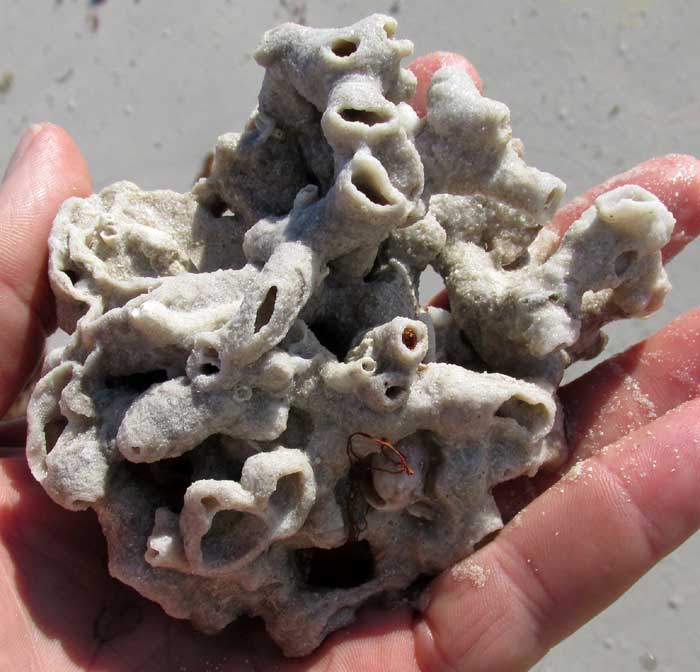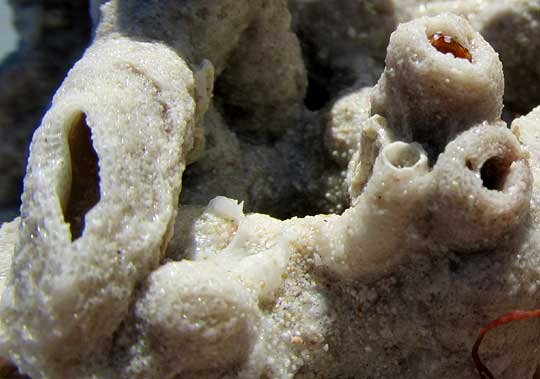Excerpts from Jim Conrad's
Naturalist Newsletter

from the November 23, 2014 Newsletter issued from Río Lagartos, on the Yucatan Peninsula's northern coast (~N21.60°, ~W88.16°), Yucatán state, MÉXICO
WORM TUBES ON THE BEACH
Washed up on the white sand of the beach on the ocean side of the barrier island across the estuary from Río Lagartos, the interesting item turned up seen above. Looking like a mass of fossilized macaroni, it was heavy and rock hard, like a chunk of coral, but it didn't look like coral. A close-up showing an important identification feature is shown below:

In the center of the right half of the picture, notice the little "chimney" with a thin, white interior wall. It's like a bent, white, plastic straw with white sand cemented to its exterior. Coral consists of communities of tiny animals cemented together, but here you see nothing of the chambers in which a coral's animals might live. When you think about it, about the only thing that might live in such curvy, long, strawlike structures is a worm, or wormlike creature who excretes a smooth, white, thin tube to which sand becomes attached.
I'm guessing that these are tubes formed by polychaete worms. A list of invertebrates identified by various experts working in this area lists several polychaete worm species.
I learned about polychaete worms while at Mayan Beach Garden Resort north of Mahahual on the Caribbean coast of Quintana Roo. There, attached to clam shells found on the beach, I noticed calcified and highly detailed squiggles looking like eel skeletons. You can see what that looked like at www.backyardnature.net/yucatan/shell-tb.htm.
Those squiggly polychaete worm tubes are very different from the much larger, sand-walled items in our current photo, but the world of polychaete worms is a big one, with over 10,000 known species, and among those species the variety of living styles is as diverse as can be imagined. You might enjoy looking over Wikipedia's illustrated Polychaete page at https://en.wikipedia.org/wiki/Polychaete.
Polychaetes are worms belonging to the Segmented Worm Phylum Annellida, so they're annelids, like earthworms. They're in the class Polychaeta, of which about 98% live in saltwater.
Most tube-dwelling polychaetes are members of the Subclass Sedentaria, and of that group I read that tubes may be built of unadorned mud, sand, or parchment, which often are decorated with sand, shell fragments, algae, tiny animals called hydroids, or of hardened calcium carbonate. A thin tube of hardened calcium carbonate decorated with sand is exactly what we appear to have.
I can't find pictures on the Internet looking like our find, but in this article I've used enough keywords -- polychaete, Sedentaria, tube-dwelling -- that web-browsing experts will eventually find this page, and maybe one of them will tell us exactly what we have, and maybe they'll be happy to know that what's shown in our photos has been spotted in the Ría Lagartos Biosphere Reserve.